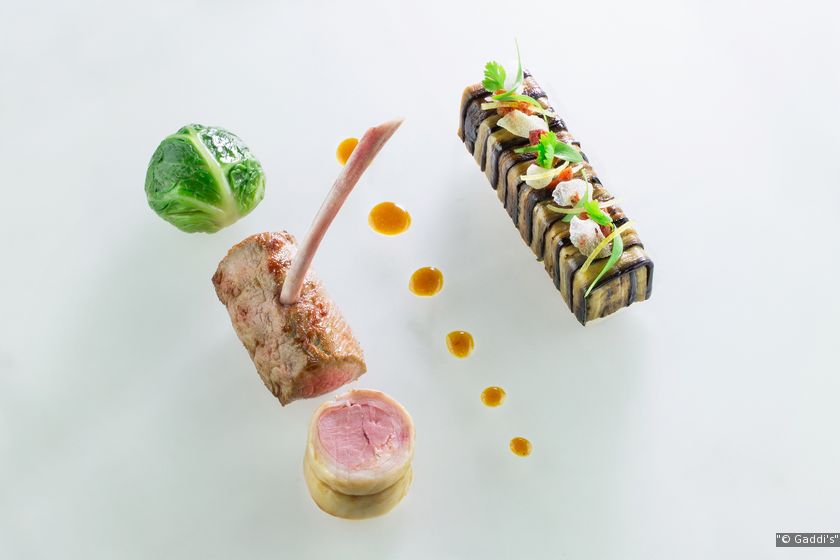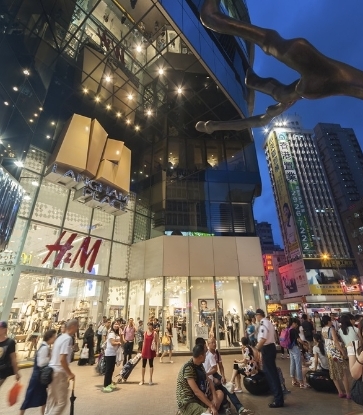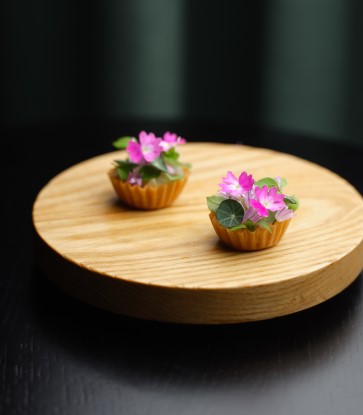Deep in the heart of The Peninsula Hong Kong, a small printer chatters with a rhythmic clicking and clacking as it churns out new dockets for Gaddi’s meal service. Head chef Xavier Boyer reads out the incoming orders and adds the tickets in sequential order to the docket rail while his brigade of chefs sound their acknowledgement and turn their attention to their respective contributions. The components come together at the pass and Boyer inspects each completed dish, making some final touches to the presentation. As he calls for service to send the dishes out to the guests, he marks the dockets and moves them down the rail until the tables are ready for their next course.
From his position at the pass, Boyer is able to monitor and control the quality and pacing of every course for every table in the restaurant. And from a small table directly facing him, separated only by the width of the pass and a busy work corridor, the guests seated at Gaddi’s chef’s table are able to intimately experience the hustle and bustle of a commercial kitchen with a full brigade.

The concept of the chef’s table originated from an age-old practice of chefs entertaining their family and friends in the kitchen as they worked. If space allowed, they sat at a small table tucked in an out-of-the-way corner; if not, they squeezed in at the pass. In time, enterprising restaurateurs began granting their regular patrons the opportunity to walk through the swinging doors for a behind-the-scenes dinner in the kitchen. And what was once an invitation-only VIP perk eventually evolved into a fully bookable table for the general public.
By dint of their location in the kitchens, guests seated at the chef’s tables have typically enjoyed more meaningful interactions with the head chefs than would be possible in the main dining rooms, as well as exclusive multi-course meals often prepared by the head chefs themselves.

French haute cuisine restaurant Gaddi’s was the first to introduce the chef’s table to Hong Kong in 2000, and nearly two decades later, it is clear that both restaurants and the dining public have wholeheartedly embraced the concept. It is also inevitable that restaurants have seized upon and refined different aspects — so much so that the chef’s table experiences now vary quite dramatically from restaurant to restaurant.
A Part Of The Kitchen Life
“Speaking from the heart, I believe that a chef’s table must sit inside the kitchen,” says Boyer. “The best moments are when guests can see and hear and feel the kitchen life.”
Though he would love to seat his chef’s table guests at the side of the pass where he himself is wont to sit and grab a bite when visiting his friends’ kitchens, he admits it would be impractical for both the chefs and the diners. He pauses and smiles ruefully as a trolley laden with dishware rattles by. Yet even that is a part of the immersive experience. “For the customer, it really is about being a part of the kitchen life.”
Gaddi’s remains one of Hong Kong’s last remaining chef’s tables still positioned inside an otherwise closed kitchen. And Boyer believes the proximity strengthens the connection between chefs and guests, and thereby helps preserve much of the original spirit of the chef’s table.

“I would say half of the guests who book the chef’s table are our regular guests, and we consider them our friends,” he says. “We can get playful with the menu and serve them what they want. If someone says he likes bell peppers, we can adjust for that.”
Gaddi’s will soon be refurbishing the area around the chef’s table to update and elevate the experience in line with some of the private room chef’s table concepts around town. But Boyer remains resolute in protecting the authentic essence of the experience.
“We considered putting up a glass between the table and the kitchen, but that idea only lasted one day,” he says. “No way. For me, the chef’s table has to stay fully integrated with the kitchen.”

An Interactive Experience
Still, there are many guests who want the behind-the-scenes glimpse into the operations of a working kitchen without subjecting themselves to the noise, the heat and the commotion that comes with the territory. For them, a fully enclosed private room that sits within or adjacent to the kitchen provides the perfect balance.
“You can call The Krug Room a type of chef’s table, though it’s not fully open to the kitchen. And what we do here is a bit different than other ones. It is more of a little, tiny restaurant hidden within the heart of the hotel,” says executive chef Robin Zavou.

Guests are escorted through the back of The Chinnery restaurant and down a service hall to a beautifully appointed private room tucked away in the center of the Mandarin Oriental, Hong Kong’s main kitchens. From there, they are afforded a window into the inner workings of the commercial kitchen by way of a set of glass windows overlooking the events kitchen, which handles preparations for both onsite and offsite catering as well as The Krug Room dinners.
The four walls shield the guests from unwanted sounds and even potentially conflicting aromas if the kitchen is also preparing dishes for other catering events, and the enclosure allows them to instead focus their senses on the music and champagne pairings around which The Krug Room experience is centered. With every course, Zavou and his sous chef Reto Weber present the dish, discuss the pairing, answer questions and generally chat with the guests.

”For me, the main point is the interaction between the chefs and the guests. We can give more insight into the dishes and the pairings. We can also have a bit of fun, be playful and get some banter going with the guests. That adds another element to the whole dining experience.”
Under Zavou’s watchful eyes, The Krug Room has become less of an offshoot of Mandarin Grill + Bar and more of a standalone chef’s table, in and of itself, where he can indulge his creative impulses and test out new ideas that may not entirely have fit with expectations of a modern grill restaurant.

“I’m a bit of a traditionalist in the sense that I feel each restaurant, whether it is Mandarin Grill, Pierre or Man Wah, should have its own identity,” he says. “The Krug Room is a playground where we have the freedom to put out anything we think will wow the guests,” he says.
Recently, guests were invited to gather around a kitchen counter to watch Zavou prepare a limoncello sorbet and chat over the pre-dessert course while The Krug Room was being set up for the final table dessert. “That was the first time we’d brought them into the kitchen like that. The response was very good, so I think we’ll carry on with it,” he says.
“You can see the trend going on with chef’s table and chef’s counters around town. Restaurants are getting cosier and chefs are trying to be more interactive with their guests. I really think that’s the way things are going forward.”

Front Row Seats
If a chef’s table on the kitchen floor can be likened to an exclusive, behind-the-curtains peek at a live performance, then a chef’s counter along an open kitchen is the front row to the stage.
“We consider ourselves a chef’s table restaurant because almost all of our seats are in front of the kitchen,” says Vicky Cheng, executive chef of VEA (pictured below), where fully 80% of the guests are seated along the counter. At this restaurant where French and modern techniques meet Chinese flavours, three tables and a private room accommodate those seeking alternative options and even the private room has a window overlooking the hot station. “Most other restaurants view their counter seating as less desirable and offer them when the tables are full. For us, it’s the exact opposite.”

“People come here, first and foremost, to enjoy the food. If the food is no good, then nothing else matters. But they are also coming to enjoy the show, which is everything going on in the kitchen,” he says.
Cheng has specifically designed the restaurant and its operations to showcase his team’s skill and artistry while optimising the guest experience. Beautiful marble countertops make for a more visually luxurious workspace and the counter gently curves around each of the three islands to provide a better view of the culinary preparations while also allowing larger parties to chat more easily amongst themselves. The amount of heat produced by the hot line is minimised by the use of induction cooktops rather than traditional gas ranges. Instead of a
POS system with chefs calling the pass, courses are managed more automatically — and more quietly.
The entire staff lines up for a physical check before service to confirm fingernails are trim, teeth are brushed, hair is tied back and uniforms are ironed. Cheng admits that the mentality required of a chef for an open kitchen is different than that for a closed kitchen, and his hit rate in hiring staff is lower as a result.
“As a chef in an open kitchen or one with a chef’s table, you have to be more disciplined and more professional. Knowing someone is watching you pushes you to perform more quickly and efficiently,” he says.
“We have to do a lot of briefings beforehand and a lot of coordinating between the front and the back of the house. And when it comes together, it’s a good show.”

Democratising The Concept
“I don’t like the exclusivity of the chef’s table’s original concept,” says Max Levy, chef-owner of Okra Hong Kong. “I like the idea of giving everybody the opportunity to see what the chefs are doing and talk to them about it. That’s why we set things up the way we did.”
On the ground floor Okra Kitchen, the trendy izakaya features a long stretch of counter seating along the open galley kitchen. Though not explicitly marketed as chef counter seats, the guests are seated directly facing the working chefs and the warm conviviality of the space fosters casual back-and-forth exchanges. Anyone can book the seats in advance or try their luck as walk-ins and then order from the regular menu at no additional cost.

Upstairs, Okra Bar requires a prepaid reservation for an omakase-only experience presided over by Levy himself. He likens it to getting a suit made in Hong Kong. “I’m trying to offer a very unique, very personalised experience,” he says. “We ask the guests what they are allergic to and what they don’t like. Beyond that, they shouldn’t have any preconceptions or expectations for specific dishes. They should be ready to be surprised.”
As a chef, Levy enjoys the yin and yang of the different concepts. “I like working upstairs in the Bar, where it’s very serious and I can really focus and concentrate on the subtleties of the food,” he says. “Working downstairs in the Kitchen is also great. The food is fun, everything is more relaxed and you get a lot more opportunities to chat with the customers.”
The challenge lies in communicating to new guests that the food and environment of the Kitchen and the Bar are wildly different. Neither is inherently better than the other and the Okra’s website states clearly that the two concepts are distinct and separate. But Levy does encourage diners to explore, over multiple visits to Okra Hong Kong, the dichotomy between the everyday dining of the casual izakaya and the unique experience of the omakase meal.
“We have regular guests who come to the Bar for the food and the private experience, but they also like the ambiance downstairs,” he says. “I think there is a shift where people are really appreciating the interactions with the chefs and the ability to watch everything going. That’s what they enjoy most about eating in the Kitchen.”

More Than One Chef
A hallmark of a restaurant’s chef’s table was once its explicit association with the eponymous head chef. But the trend is shifting towards a recognition and celebration of the entire culinary team, with chefs tag-teaming the table and introducing their contributions to the multi-course meal.
“Let’s not call it a ‘chef’s table’. It’s a ‘chefs’ table’,” says Boyer of Gaddi’s. “If it were only me cooking, I could only do this table and I couldn’t oversee the rest of the restaurant. It is because of the team that we can do this table and they deserve to be involved with the experience.”
VEA’s Cheng agrees: “The point of the kitchen is to highlight not just me, but the entire team. They are the ones on that ‘stage’. They are proud of what they do and they appreciate being able to explain what they have created.”
Levy of Okra Hong Kong points out the dilemma that many restaurants are facing with head chefs being required to travel more and more. When the head chef isn’t there, can restaurants still offer the chef’s table and are people willing to dine there?
Levy says: “The shift to a chef’s counter is a response to that and it gives restaurants more flexibility in telling guests, ‘This gives you a view of the kitchen and the opportunity to interact with the chefs working there’. I think for the most part, people are happy with that.
“We will always have the fine-dining restaurants with the intimate tables in the kitchen. But look at L’Atelier de Joël Robuchon and Frantzén's Kitchen, where guests are sitting at the bar counter,” says Zavou of The Krug Room. “I think we’re going to see more and more chefs coming out and having interactions with the guests. And the chef’s table in that sense is everyone sitting around the chefs’ counter and having good fun. It feels like that is the way forward.”
Banner image courtesy of Mandarin Oriental, Hong Kong





















